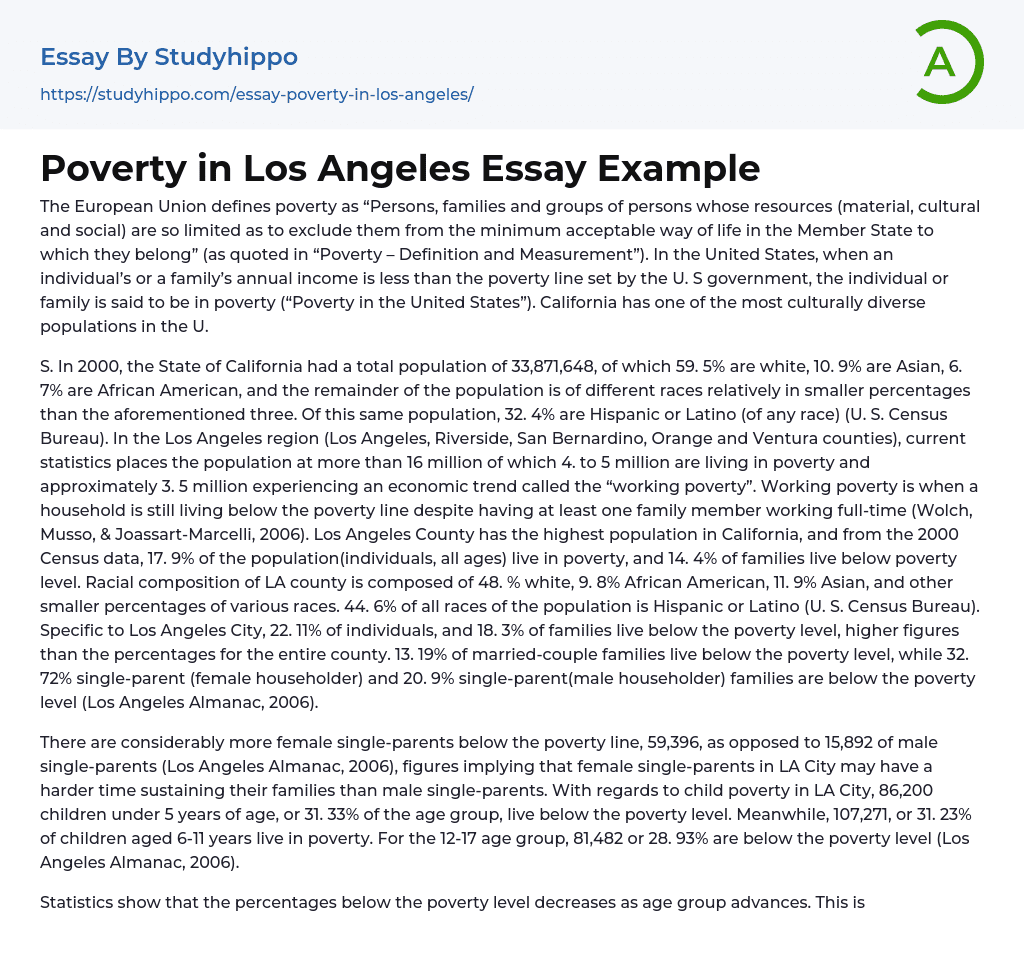The European Union defines poverty as “Persons, families and groups of persons whose resources (material, cultural and social) are so limited as to exclude them from the minimum acceptable way of life in the Member State to which they belong” (as quoted in “Poverty – Definition and Measurement”). In the United States, when an individual’s or a family’s annual income is less than the poverty line set by the U. S government, the individual or family is said to be in poverty (“Poverty in the United States”). California has one of the most culturally diverse populations in the U.S.
In 2000, the State of California had a total population of 33,871,648, of which 59. 5% are white, 10. 9% are Asian, 6. 7% are African American, and the remainder of the population is of different races relatively in smaller percentages than the af
...orementioned three. Of this same population, 32. 4% are Hispanic or Latino (of any race) (U. S. Census Bureau). In the Los Angeles region (Los Angeles, Riverside, San Bernardino, Orange and Ventura counties), current statistics places the population at more than 16 million of which 4. to 5 million are living in poverty and approximately 3. 5 million experiencing an economic trend called the “working poverty”. Working poverty is when a household is still living below the poverty line despite having at least one family member working full-time (Wolch, Musso, & Joassart-Marcelli, 2006).
Los Angeles County has the highest population in California, and from the 2000 Census data, 17. 9% of the population(individuals, all ages) live in poverty, and 14. 4% of families live below poverty level. Racial composition of LA county is composed o
48. % white, 9. 8% African American, 11. 9% Asian, and other smaller percentages of various races. 44. 6% of all races of the population is Hispanic or Latino (U. S. Census Bureau). Specific to Los Angeles City, 22. 11% of individuals, and 18. 3% of families live below the poverty level, higher figures than the percentages for the entire county. 13. 19% of married-couple families live below the poverty level, while 32. 72% single-parent (female householder) and 20. 9% single-parent(male householder) families are below the poverty level (Los Angeles Almanac, 2006).
There are considerably more female single-parents below the poverty line, 59,396, as opposed to 15,892 of male single-parents (Los Angeles Almanac, 2006), figures implying that female single-parents in LA City may have a harder time sustaining their families than male single-parents. With regards to child poverty in LA City, 86,200 children under 5 years of age, or 31. 33% of the age group, live below the poverty level. Meanwhile, 107,271, or 31. 23% of children aged 6-11 years live in poverty. For the 12-17 age group, 81,482 or 28. 93% are below the poverty level (Los Angeles Almanac, 2006).
Statistics show that the percentages below the poverty level decreases as age group advances. This is an indication that families below the poverty line tend to have more children, and the children often feel the greatest effects of poverty. Among the communities of Los Angeles City, the following have the highest percentages of individuals below the poverty level: Chinatown (61. 19%), Watts (47. 66%), Pico Union (44. 24%), Central City (41%), Southest LA (38. 82%), Central City East (36. 04%). Koreatown (35. 89%), South LA (35.
75%), Westlake (35. 3%), and Lincoln Heights (34. 09%) (Los Angeles Almanac, 2006).
It can also be seen from the first table above that 9 out of the ten communities are dominated by Hispanics. Greater results would then be gained if efforts to alleviate poverty are first targeted towards Hispanic communities, and then to African American and Asian communities. Education is one of the combatants of poverty. The higher the achieved educational level, the better the chances are of an individual getting a good job.
In 2000, there are 2,308,887 individuals aged 25 and older in the City of Los Angeles, 770,172 of these, or 33. 36% never graduated from high school (Los Angeles Almanac, 2006). This is perhaps one of the causes of poverty in the city. To further illustrate how education affects poverty, the table below shows the educational attainments of the population of the same 10 communities previously listed.
- Overpopulation essays
- Homelessness essays
- Hunger essays
- Dumpster Diving essays
- Homelessness In America essays
- Alaska essays
- Boston essays
- Brazil essays
- California essays
- Canada essays
- Chicago essays
- Costa Rica essays
- Florida essays
- Hawaii essays
- Latin America essays
- Los Angeles essays
- Mexico essays
- Slavery In America essays
- Usa essays
- Virginia essays
- Washington essays
- Abortion essays
- Abuse essays
- Animal Rights essays
- Animal Testing essays
- Assault essays
- Bullying essays
- Controversial Issue essays
- Crash essays
- Cyber Bullying essays
- Feminism essays
- Human Rights essays
- Immigration essays
- Inequality essays
- Poverty essays
- Prejudice essays
- Racism essays
- Torture essays
- Violence essays




